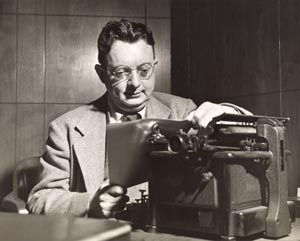
Screenshot of a new documentary called The Legacy of I.F. Stone, which is available on Vimeo and at www.ifstone.org.
That notion was part and parcel of the idiosyncratic and ravenous ways of Stone, one of great muckraking journalists, who’s subject of two new video tributes released Wednesday that could be a primer for anybody in the news business today.
Stone (1908-1989) was essentially a dazzling pre-Internet blogger, whose weapon was a manual typewriter, a two-finger peck-and-poke style of typing and a print newsletter that once claimed 70,000 subscribers.
But at the heart of work that made him both a hero to many and a pariah to the establishment, which could include parts of the journalism establishment, was an insistence that important truths can get buried, out of deceit, laziness or misunderstanding.
And when it came to government itself, his work life was animated by the driving notion that, by and large, it tends to lie, especially about important matters.
Whether it was during the Red-baiting of the McCarthy Era during the 1950s, the Vietnam War or the daily functioning of the federal government he observed, Stone continually broke big stories in his little four-page newsletter that proved that people in power were fudging. Those included his damning questions about how media reported on an 1964 incident in the Gulf of Tonkin, involving an alleged unprovoked attack against a U.S. destroyer, which would provide the dubious basis for President Lyndon Johnson’s escalation of the Vietnam War.
He was not always heralded during his lifetime. But in 1999, a New York University journalism panel ranked his newsletter, “I.F Stone’s Weekly,” as the second most important print product of the 20th century.
Further, both Harvard University’s Nieman Foundation for Journalism and Ithaca College present annual awards in his name that herald exemplars of great independent work.
What’s being released Wednesday are a 12-minute video biography and an accompanying 30-minute video of longer interviews with the likes of filmmaker Michael Moore and journalist Glenn Greenwald, who assisted former National Security Agency contractor Edward Snowden in bringing to light his controversial disclosures of government spying.
It’s an effort of the non-profit called Catalytic Diplomacy, with funding from the John S. and James L. Knight Foundation, and is produced by White Pine Pictures of Toronto. The hope is to parlay it into a larger documentary, perhaps akin to a strong documentary on him, “IF. Stone’s Weekly,” that was released in 1973 (and called “by turns angry, frightening and funny” by critic Roger Ebert).
Stone was indefatigable and nervy, with both respect for great journalists and suspicion of many, especially those who plied their trade in the nation’s capital.
“His great line was you have to wear a chastity belt to preserve your journalistic integrity since once the Secretary of State invites you to lunch you’re sunk,” recalls longtime capital journalist Myra MacPherson, (cq) who is interviewed in both videos and is author of “All Governments Lie: The Life and Times of Rebel Journalist I.F Stone.”
Greenwald suggests in the longer video that Stone should be an inspiration in an Internet world, “where individuals can build a platform without the institutional limitations of a big corporation.”
He’s correct in noting how when it came to be isolated from those in both government and media power, “He viewed his exclusion from those circles as the minimum requirement that someone was doing his job as a journalist.”
It’s no surprise that he became a hero to some other journalists, including a young Carl Bernstein of the Washington Post and Seymour Hersh, who themselves would become associated with reporting on the Watergate and Vietnam War’s Mylai Massacre scandals, respectively.
His assistant for a period during the mid-1960s was Peter Osnos, who went on to distinguished careers as a reporter and editor at the Washington Post and in book publishing and recounted his experience in an engaging 2006 preface to a collection, “The Best of I.F. Stone.”
On Wednesday, I asked him why journalists today should care about Stone.
“In many significant ways, Izzy’s work is a model for what today’s best reporters can achieve. His I.F. Stone’s Weekly was a forerunner of the best of today blogs.”
“He did prodigious digging in the official documents of the day and read widely in global newspapers and magazines. He then put his findings into crisp opinionated writing that had revelations from his reporting combined with style and wit. By the standards of the time in the mid- 1960s, Izzy’s newsletter with 70,000 subscribers was a celebrated paragon of independent thinking and a pleasure to read.”
That nails it. But even better is perusal of an official site that includes lots of his work: www.ifstone.org
Take a look. It’s both humbling and an inspiration.
The Legacy of I.F. Stone Part 1:
The Legacy of I.F. Stone – Part 1 (master vimeo) from WhitePinePictures on Vimeo.
The Legacy of I.F. Stone Part 2:
The Legacy of I.F. Stone – Part 2 (master vimeo) from WhitePinePictures on Vimeo.







Comments